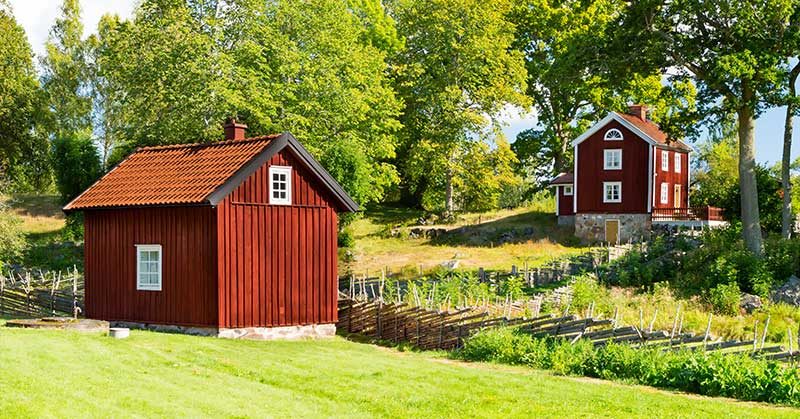By the year 2050, the world’s population is expected to reach nearly ten billion. This means that in that time, global food production must increase by fifty percent [1]. Could small farms offer a potential solution?
Large-scale agricultural production is often purported as the solution to feeding the world, however bringing more land under agricultural production will not solve the problem of global hunger [2].
In fact, over the last few decades it has become increasingly clear that modern industrial agriculture is not a cost-effective, healthy, or sustainable way to feed the world, and as the concentration of farmland has been put in the hands of fewer and fewer players, world hunger has only increased [3].
Small farms, on the other hand, are often more productive and have less of a negative impact on the environment when compared to large industrial farms. These smaller operations, however, are disappearing as they get pushed out by corporate farms.
As the world’s population continues to grow, finding ways to sustainably feed everyone across the globe is becoming a bigger and bigger issue, and small farms may be the solution.
What is a Small Farm?
There is confusion over what is considered a “small” or “family-owned” farm. The United Nations (UN) Food and Agricultural Organization (FAO) loosely defines a family-owned farm as any farm that is managed by an individual or household. They admit, however, that there is no precise definition, and that definition varies depending on the country.
Because of this, in 2014 the FAO released a report that said family farms manage 70 to 80 percent of the world’s farmland, and produce 80 percent of the world’s food. On the ground, however, it is clear that this is not the case [4].
In fact, an in-depth survey conducted by GRAIN determined that small farmers hold just 24 percent of the world’s farmland [5].
So where is the discrepancy happening? The answer goes back to the very rough definition of what is a family farm, which includes a massive industrial soya bean farm in Argentina that’s owned by a family in Buenos Aires- and that’s just one example [4].
The Plight of the Small Farmer
In countries around the world, from Honduras to Kenya to Palestine to the Philippines, people are being dislodged from their farms so that their land can be used for industrial farmland to grow crops like soya bean, oil palm, rapeseed, and sugarcane [5].
Over the last five decades, 140 million hectares of farmland have been taken over by those four crops. These crops do not feed people but instead are grown for the agro-industrial complex, which relies heavily on fertilizers and pesticides [4,6].
Small farms have been getting even smaller over time because of a variety of factors including land concentration, population pressure, and lack of access to land. Small farms have been shrinking, in some place by as much as 50 percent, and today the average size of a small farm is a mere 2.2 hectares. These tiny plots make up 90 percent of all farms worldwide [5].
Read: Paris Is Building the World’s Largest Organic Rooftop Farm
Small Farms Could Solve World Hunger
These small farms, however, are more productive per-hectare than large scale industrial operations, and experts believe that they are the solution to feeding our growing population. This is because small farms prioritize production, and focus on feeding their own families, and on local and national markets.
One UN study determined that if small producers and agro-ecological farming methods were adequately supported, global food production could double within ten years while mitigating climate change and alleviating rural poverty [7].
If the large-scale operations matched the per-hectare yields of Kenya’s small farms, the country’s agricultural output would double. In Central America, it would triple, and Russia’s output would increase by six times its current levels [4].
One of the main reasons why these small farms can solve world hunger is because they protect biodiversity. Currently, twelve plants and five animal species make up 75 percent of what the world eats, This means that our food systems are incredibly vulnerable to natural disasters and disease outbreaks [8].
Agroecological farms could be an effective alternative to damaging industrial farming. It could reduce the use of artificial chemicals, maintain the soil quality, and work with the local environment instead of against it.
“Diversity is the key,” says Vicki Hird, food and farming campaigner at Sustain, an NGO. “Having these huge monocultures does not lend itself to being managed in a natural way, and can damage biodiversity.” [2]
Ronald Vargas, a soil and land officer at the FAO, says that small farms will be key to making the transition from industrialized farming to agroecology. According to the FAO, supporting these farmers is urgent, and is the most promising means of combating hunger while minimizing the damaging impact that agriculture has on the environment [2].
Support Small Farms
There are many ways in which you can support small farms that use environmentally-friendly practices and treat workers properly. One way you can do this is by buying fairtrade as much as possible.
The easiest way, however, to support small farms is to buy local. There are nearly nine thousand farmers markets across the United States, and more grocery stores are beginning to stock local produce. By purchasing these products, you are providing farmers with a reliable outlet to sell their produce, which allows them to stay in business [8].
The more we look at the numbers, the clearer the message becomes: we must give farmland back to small farmers. We need agricultural policies to support these producers, and we as a society need to actively support them so they can continue to feed our growing numbers.
Read: Why Independent Farming in America Is Close to Extinction
- https://www.wri.org/blog/2018/12/how-sustainably-feed-10-billion-people-2050-21-charts
- https://www.theguardian.com/news/2019/jan/28/can-we-ditch-intensive-farming-and-still-feed-the-world
- https://www.ucsusa.org/resources/hidden-costs-industrial-agriculture
- https://theecologist.org/2014/nov/22/want-double-world-food-production-return-land-small-farmers
- https://www.grain.org/e/4929
- https://erenow.net/postclassical/1493-uncovering-the-new-world-columbus-created/6.php
- https://www.grain.org/e/4219
- https://www.nationalgeographic.com/environment/future-of-food/photos-farms-agriculture-national-farmers-day/

